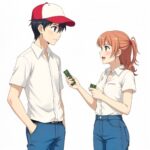Reader’s Question:
Is there a difference between “shota” and “bishounen”?
Understanding “Shota” and “Bishounen”: An Anime Lover’s Perspective
Ah, the world of anime! A colorful universe full of vibrant characters, intricate storylines, and, of course, a unique lexicon that can baffle even the most seasoned fans. One such topic that often sparks
debates among the community is the distinction between “shota” and “bishounen.” As someone who has been deeply immersed in this domain since my childhood (shoutout to my days in Osaka!), I thought it might be helpful to dive into this topic and share my own thoughts and experiences.
What’s the Big Deal?
First things first, let’s break down the basics. To put it simply, “shota” refers to young boys—often pre-teens—who are portrayed in a way that appeals to certain interests, particularly in fan culture. On the other hand, “bishounen” translates to “beautiful boy,” typically referring to adolescent boys with strikingly attractive features. Now, you might be wondering, “Isn’t a beautiful boy just a young boy?” Well, not quite! Here’s where it gets interesting.
The Age Factor
From my understanding, and as one commenter pointed out, shota usually depicts boys from around the age of three (when they start talking) to elementary school age. These characters often embody innocence and playfulness, and their appeal lies in their youthfulness rather than their looks. It’s less about being handsome and more about capturing that childlike essence. Bishounen, however, can span a wider age range, typically covering boys from around five years old all the way into their teenage years (think high school!). These characters are often crafted with a focus on their beauty, showcasing not just their physical attractiveness but also their charm and charisma. It’s like comparing a sweet, innocent cupcake to a perfectly styled, upscale dessert—both delightful, but for different reasons!
The Cultural Context
Being born in California and raised in Osaka, I’ve had the opportunity to experience both Western and Japanese takes on beauty standards. In Japan, the concept of beauty for young boys—especially in anime and manga—can be significantly different from Western portrayals. While shota can verge into more questionable territory due to its associations with certain fandoms, bishounen are celebrated for their aesthetics, often becoming the heartthrobs of many a series. This dichotomy sometimes leaves fans feeling conflicted. In my own anime journey, I’ve found myself loving shota characters for their adorableness—like the playful antics of Gon from “Hunter x Hunter.” Conversely, I can’t help but swoon over the striking features of characters like Ikuto from “Shugo Chara!” It’s a wild ride!
Shota and Its Controversy
Now, let’s get real for a second. The term “shota” can raise eyebrows, and rightfully so! It’s often associated with more mature themes and fandoms that some might find problematic. As one commenter mentioned, terms like “shota-con” originated from a rather specific niche within anime culture. While I appreciate the innocence and charm of shota characters, I understand that the implications of such terms can lead to uncomfortable discussions. As someone who enjoys stand-up comedy and manzai, I believe humor and awareness can both coexist. I’ve seen way too many jokes that tread into murky waters, and that’s where my cautionary side kicks in. For me, it’s about celebrating the innocence of childhood without crossing any lines.
Bishounen: The Heartthrobs of Anime
On the flip side, let’s talk about bishounen! Ah, the beautiful boys who steal hearts and inspire fan art. I remember the first time I laid eyes on Tamaki from “Ouran High School Host Club.” The way he carried himself, his dreamy eyes, and that beautiful hair—it was like I was struck by Cupid’s arrow! Bishounen characters often come with an array of personalities—from the cool and aloof type to the charming goofball. They tend to be the focus of many romantic subplots, and let’s be honest, they’re often the ones we dream about. What’s not to love about a character who can effortlessly pull off both a dramatic monologue and a goofy smile?
The Personal Connection
Reflecting on my travels through anime and manga, I’ve come to appreciate these distinctions not just as a fan but also as a father. I want my child to enjoy these worlds as much as I did, but I also want to navigate the content carefully. For instance, certain shota series might be too much for a young mind to comprehend fully. I often find myself introducing my child to the more wholesome side of anime, full of adventure and friendship—think “My Neighbor Totoro” rather than more mature themes. There’s something magical about watching that spark of interest light up their eyes. And trust me, when they giggle at a silly moment, it reminds me of my own childhood in Osaka, laughing at manzai skits on TV.
The Final Thoughts
So there you have it! While shota and bishounen might seem like they occupy the same universe, they’re really like two sides of the same coin. One represents the charm and innocence of youth, while the other embodies beauty and allure. Both have their unique place in the anime landscape, and it’s up to us as fans to appreciate them while maintaining a healthy perspective. As I continue to explore the vast sea of anime with my little one, I hope to strike a balance, celebrating both the cuteness of shota and the beauty of bishounen in a way that’s appropriate and enjoyable for all. Who knows—maybe one day we’ll even find our favorite characters together, creating new memories and laughter along the way! Until next time, keep those anime recommendations coming! And remember, whether it’s shota or bishounen, there’s always something to love in the world of anime.



